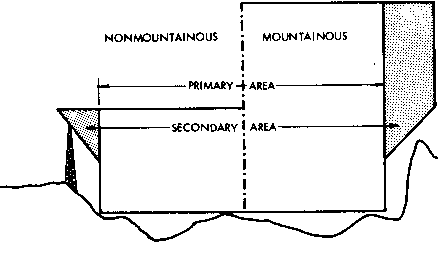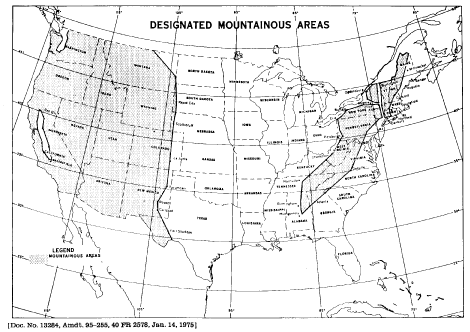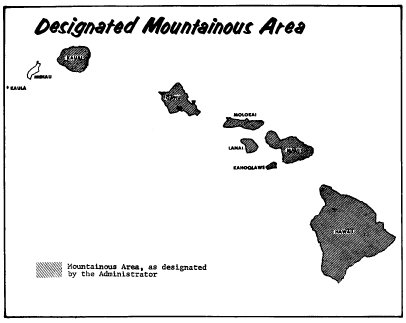Determining if you are located within a MOCA
The Minimum Obstacle Clearance Altitude is the lowest published altitude in effect between radio fixes on VOR Airways, off airway routes, or route segments which meets obstacle clearance requirements for the entire route segment and which assures acceptable navigational signal coverage only within 25 SM (22NM) of a VOR.
Regulations covering protection airway routes is specified in the Federal Aviation Regulation (FAR):
FAR Part 77.23 Standards for determining obstructions.
(a)(4) A height within an en route obstacle clearance area, including turn and termination areas, of a Federal airway or approved off-airway route, that would increase the minimum obstacle clearance altitude.
There are approximately 45,000 miles of Federal Airways covering the United States. Airways have a primary area width of 8 nautical miles and 2 nautical miles in the secondary area. The secondary area begins on the outside edge of the primary area. Each airway has two secondary areas. Airways extend between electronic navigation facilities maintained by the FAA. These facilities are called Very High Frequency Omni-Range or VOR for short.
Example of Airways

How Airways are Protected
In order to protect these airways minimum obstacle clearance altitudes have been established. The obstacle clearance altitude is called a MOCAs. A value called the required obstacle clearance (ROC) is established to protect the MOCA. To apply the criteria you subtract the specified ROC from the MOCA. The resulting AMSL value is the maximum elevation a structure can be constructed and still not effect the MOCA. Penetration of the MOCA will result in a HAZARD determination from the FAA during an aeronautical analysis.
The airways are themselves regulations, FAR 95 and the 8260.3 (TERPS) manual govern the establishment and publication of the routes.

Airspace OMS Software – MOCA Module
Our Airspace software will locates all Airway/MOCA routes and determine if your proposed structure is within the boundary of the protected flight path. This is done for all low altitude airways. If your proposed structure is within the limits of the airway an analysis of the MOCA requirements and ROC determines the maximum allowed height at a specific latitude/longitude location.
The amount of required obstacle clearance (ROC) depends upon where your site is located (see FAR Part 91.177). The required obstacle clearance is 1000 feet in non-mountainous terrain and 2000 feet in designated mountainous areas. The extra clearance over mountains is because of the Bernoulli effect as air flows over the mountains. Fast moving winds forced over mountainous terrain can cause large variations in the pressure gradient at given true altitudes, resulting in large altimeter errors.
In certain mountainous areas, that 2000-foot minimum may be reduced. A 1500-foot clearance is allowed in the mountainous areas of the Eastern U.S., Puerto Rico and Hawaii. In the Western U.S. and Alaska, the clearance may be reduced to 1700 feet.
§ 95.13 & § 95.15 – (Eastern and Western United States Mountainous Areas)

§ 95.17 Alaska Mountainous Area

§ 95.19 Hawaii Mountainous Area

§ 95.21 Puerto Rico Mountainous Area

14 CFR – CHAPTER I – PART 91§ 91.177 Minimum altitudes for IFR operations.
1. Operation of aircraft at minimum altitudes. Except when necessary for takeoff or landing, no person may operate an aircraft under IFR below —
- (I) The applicable minimum altitudes prescribed in parts 95 and 97 of this chapter; or
- (II) In the case of operations over an area designated as a mountainous area in part 95, an altitude of 2,000 feet above the highest obstacle within a horizontal distance of 4 nautical miles from the course to be flown; or
2. In any other case, an altitude of 1,000 feet above the highest obstacle within a horizontal distance of 4 nautical miles from the course to be flown. However, if both a MEA and a MOCA are prescribed for a particular route or route segment, a person may operate an aircraft below the MEA down to, but not below, the MOCA, when within 22 nautical miles of the VOR concerned (based on the pilot’s reasonable estimate of that distance).
3. Climb. Climb to a higher minimum IFR altitude shall begin immediately after passing the point beyond which that minimum altitude applies, except that when ground obstructions intervene, the point beyond which that higher minimum altitude applies shall be crossed at or above the applicable MCA.
